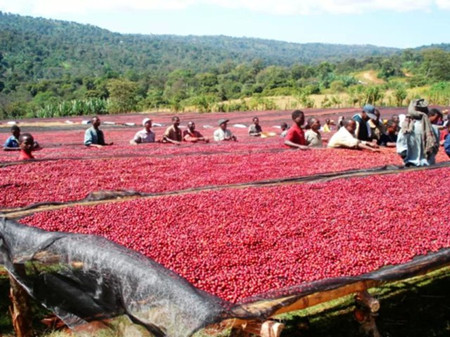The King of Fine Coffee-- introduction to the Variety of Rosa Fine Coffee

Guatemala Rosa-Akatilan fruit producing area (Guatemala Acatenango Gesha).
In 2007, Guatemala added the eighth coffee producing area, Acatenango Valley (R), which we translated into "Akatilang region".
In 2007, Anacaf é (Guatemalan Coffee Association) not only promoted it at the SCAA exhibition, but also arranged a special topic to explain to the international judges during the national competition. In the past, Guatemala claimed to have seven major producing areas, not only distinguishing features, but also giving buyers and consumers a good memory. Antigua, Micro Plateau, Lake Attitan, Koban Rain Forest and so on, each district can find excellent manors and good coffee with local characteristics.
Acatenango is located in Chimaltenango province, Guatemala. More than 5000 hectares of coffee farms in the region have fertile volcanoes, mainly located in two major volcanic mountains, and almost all have forests and shade trees. As can be seen from the above photos, almost all of the estates are shaded and planted, and the main varieties are bourbon and some Catuai and Caturra.
Akatilango two major volcanoes, Volcan de Fuego and Volcan Acatenango respectively, especially Acatenango is the third peak of Central American volcanoes, and across the Fuego volcano is the Yatitan Lake region. The annual rainfall in this area is 48 to 72 inches, and the average annual temperature is 14 ~ 31 degrees C. the temperature difference is large enough, so the density of beans is compact, which is helpful to the flavor. The coffee harvest season is mainly from mid-January to March. At present, the Kaqchiquels people still live in this area and maintain traditional farming methods; there are a total of about 4000 farmers in this area, and coffee planting dates back to 1880.
Important Notice :
前街咖啡 FrontStreet Coffee has moved to new addredd:
FrontStreet Coffee Address: 315,Donghua East Road,GuangZhou
Tel:020 38364473
- Prev

The King of Fine Coffee-- introduction to the Variety of Rosa Fine Coffee
Panamanian Emerald Manor-Esmeralda Manor (Panama Geisha Hacienda La Esmeralda) in its early years, Esmeralda Manor (Esmeralda) mostly followed Japan in its recognition of top coffee, while Geisha, with its hurricane-like power, swept through the coffee world, and the coffee revolution was so fierce that the first queen, who had occupied the throne of the coffee kingdom for a long time, had to retreat from the Blue Mountains of Jamaica and Kona Hawaii.
- Next

Introduction to boutique coffee-- introduction to the cultivation of Java coffee in Sumatra
Java coffee is produced on the Indonesian island of Java and belongs to Arabica coffee. After baking, the bitter taste is extremely strong and the aroma is very light, without sour taste. The bitterness and mellowness of Java coffee, coupled with the sweetness of chocolate syrup, make Java coffee more mellow and palatable and very popular with women! Among the Asian coffee-producing countries, Indonesia is a very noteworthy one. Indonesia is a member of the Indian Ocean.
Related
- Detailed explanation of Jadeite planting Land in Panamanian Jadeite Manor introduction to the grading system of Jadeite competitive bidding, Red bid, Green bid and Rose Summer
- Story of Coffee planting in Brenka region of Costa Rica Stonehenge Manor anaerobic heavy honey treatment of flavor mouth
- What's on the barrel of Blue Mountain Coffee beans?
- Can American coffee also pull flowers? How to use hot American style to pull out a good-looking pattern?
- Can you make a cold extract with coffee beans? What is the right proportion for cold-extracted coffee formula?
- Indonesian PWN Gold Mandrine Coffee Origin Features Flavor How to Chong? Mandolin coffee is American.
- A brief introduction to the flavor characteristics of Brazilian yellow bourbon coffee beans
- What is the effect of different water quality on the flavor of cold-extracted coffee? What kind of water is best for brewing coffee?
- Why do you think of Rose Summer whenever you mention Panamanian coffee?
- Introduction to the characteristics of authentic blue mountain coffee bean producing areas? What is the CIB Coffee Authority in Jamaica?

